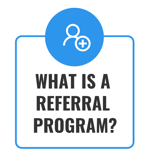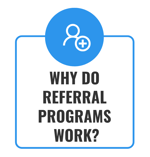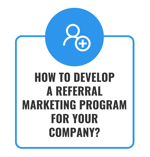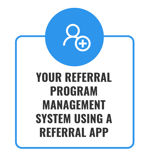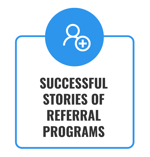
Referral Program
Get Your Referral App for Your Referral Marketing Program
In all kinds of businesses, you should look for quality over quantity when it comes to finding leads.
That's why referrals are perfect for this market.
With happy customers and the best referral program in place, you can grow your business substantially.
Referral Program
A word of mouth recommendation is a primary factor behind 20%-50% of all purchasing decisions and studies show that people are 4x more likely to buy a product or service when it is recommended by a friend or family.
Setting up a referral program with an easy and fast tool to make your customers refer you can be a game change to your business and GetTheReferral will help you with that.
1. What is a referral program?
Before you think about how to build a referral program or create a referral program, first, you need to understand what a referral program is.
It's the “tool” or process used to organize the company’s referral marketing: the act of spreading the word about a product or service through a business’s existing customers, among other groups of people. Maybe you already collect referrals for your company or even have a referral program in place but learning how to optimize it will bring you the best results.
We listed below, the different referral program stages and the reasons you should thrive for the best option in the market.
Stage 1: Poorly Tracked Referral Program. At this stage, referrals are not frequent and formally registered: sales reps write them in pieces of paper or just mention them in conversations, with no real record or tracking tool. If there is no process to promote and collect the referrals, they are frequently lost or forgotten, and customers don’t get a reward for their efforts.
Stage 2: Poorly Structured Referral Program. Going a step further, you work with a simple tool, like an excel spreadsheet, and you rely on the sales rep to follow up on it. But we know sales reps have a lot on their plate so they may not follow up with the frequency that your business needs. Referrals are lost at this stage too! Prospects get frustrated if they are not contacted within a few days and you lose business opportunities.
Stage 3: Poorly Integrated Referral Program. Here, you enter the referral in your CRM, the sales rep follows up and manually tracks what happens after that. Rewards are gift cards or checks, but it’s your job to send them and verify if the customers received them. At this stage, you may have some level of control, but the process is not smooth! You still have to push the sales reps to follow up in the system and it’s your responsibility to be sure the customer gets his/her reward.
Stage 4: Poorly Communicated Referral Program. Your customers can submit referrals through your website and you track them via a web form. These referrals are being sent to your CRM, but still, it’s difficult to keep your customers informed about your referral program and communicate with them.
Stage 5: Completely Automated and Integrated Program with a Referral Software. For the customers, an automated and mobile-friendly referral program makes their life much easier since they can submit referrals through a mobile app and also a webpage (according to comScore, people spend 50% of their digital time with smartphone apps versus 34% on a desktop), increasing their chances of referring friends and family. The referral app is more than only a referral tool, it’s a communication tool: your company can send the Advocates messages, emails, push notifications and keep them up to date with their referrals.
For the companies, the platform optimizes the referral collection and tracks everything on a dashboard. You can set up automatic rewards and add bonus amounts for additional efforts. Ultimately, an open API allows you to integrate the referral program with your CRM, giving you complete connectivity with your business!
I think that by now you should know that a referral program is extremely necessary for your business and stage 5 is a no brainer, right? But we still want to give you more information about why you should set up your referral program now!
2. Why do referral programs work?
The main reason referral programs work is because they bring the element of trust to your prospect. People trust people more than anything else when deciding about a purchase. According to Nielsen, 92% of people trust recommendations from family and friends more than any other form of marketing.
3. How to develop a referral marketing program for your company?
3.1. Set referral goals and targets.
With referral programs, you need a clear goal before you can incorporate metrics into your business decisions. Only after you have your goals, you can track your referral funnel to get the results you want. As in any other marketing strategy, you need to set up SMART goals. SMART will respond to:
S: Specific
M: Measurable
A: Achievable
R: Relevant
T: Time-Bound
3.2. Identify all your referral sources: Customers & Clients
Referrals can come from outside of the company as far as for the inside teams. Every interaction you have and every relationship you build can cause a positive experience that can be shared with others and end up with a referral. That’s why, in your company's referral program, you have to first include your past and current loyal customers. But like we mentioned, in word of mouth marketing, referral sources aren't just restricted to having an existing customer refer their friends and family to try your product and services. You also have to include employees, sales reps, business partners, and, in recent trends, influencers who can spread the word about your product on social media.
3.3. Decide on a bonus & compensation plan to incentivize your Customers
A good way to show appreciation to the customers referring you is to reward them with different levels of incentives based on the quality and stage of the referral they send you. For example, you can provide an incentive for any referral that results in a sales appointment, like a coupon (regardless of whether the referral makes a purchase). Then, you can offer a better incentive if the referral closes the deal. This is a great option for businesses that have a long sales cycle. When you set up incentives this way, it helps you increase the quality of the referrals you receive since incentives are tied to it.
In terms of types of rewards, you can go with the old and famous gift card: they allow Advocates for guilt-free spending to buy something tangible that they may have been wanting to purchase for some time such as new golf clubs or running shoes. The tangible gift purchased with the gift card will remind them of your brand and what they did to achieve the reward.
You can also offer store credit, coupons, upgrades in products or services, discounts on bills (if you work with ongoing/ monthly services or subscriptions) and the list is unlimited!
Some companies are really creative about it. They connect eCommerce customers to cashback deals from many retailers. Their referral program basically offers a lifetime value (LTV).
For example, Dropbox is now considered the leader in cloud file sharing but it wasn't always like that. They struggled at first until their referral program of promising free extra storage for each referral. This took them from 100,000 users to 4,000,000 in just 15 months.
Evernote, the cloud-based note-taking service, set up an entire points program based on how much you refer new customers to them. The Evernote Rewards Program is one of the most successful referral program examples of a comprehensive reward and compensation program.
And practically any industry or segment can benefit from referrals. Crowdsourcing services let investors earn money by referring new investors to them.
3.4. Implement a tracking system
Why should you track your referrals? The answer is “because you should.” No competent digital marketing team should be left without a referral tracking system. No matter what method you use to track referrals, you need to trace back who is referring to your company. With an automated platform, you increase the chances of being more effective and assertive in your approach.
When you track your referrals, you can figure it out:
The number of Advocates signing up on your program: At the end of the day, any business wants to have as many Advocates as possible (meaning 1 customer = 1 Advocate). You don’t need to limit your list of Advocates to current customers, as mentioned many times before, you can expand the list of your referral sources to friends, family, employees, influencers, etc. This is especially true with products and services in the lifestyle or fashion business. Many cosmetics, clothing, sandals, and footwear companies rely on excellent word-of-mouth from happy customers and almost always end up recommending a product they were happy with. Charities also rely heavily on this system of advocates, with companies offering a donation to a charity for each referral or charities offering a special service in return.
Who are your best Advocates! Your best Advocates would be the ones who send you more referrals and those referrals end up as closed deals for your business. The average of referrals per Advocates is around 2, but if your company takes the referral program seriously and tracks referrals on a daily or weekly basis, the number can be double or even triple.
Which sales reps are working more frequently with the Advocates: One of the pivotal elements of a successful referral program is to have your sales reps engaged with it. This includes providing training about the program and how to ask for referrals.
Also, it’s important to know what you are doing to hold your sales reps accountable. A great idea is to build a plan with a quota for referrals (it can be a week or a month plan). That way you make sure they are on board and aiming to mention your referral program in all stages of the selling process and even reaching out past customers to have them sign up and refer to. You will then track the referrals per sales reps and reward them properly, based on their referrals’ performance.
The furniture retailer Made.com depends completely on referrals anytime, anywhere, as its business model depends on connecting designers directly with customers and asking them for any type of referral. Basically, the sales reps are part of the service the company offers.
More About The Referral Program...
4. Your Referral Program Management System Using a Referral App
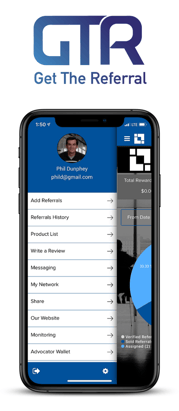 4.1. Make it easy for referral sources to refer your business Using a Referral App
4.1. Make it easy for referral sources to refer your business Using a Referral App
The best way to reach out and keep in touch with your customers is through a referral app, and there are two main reasons for that: In the U.S., 77% of adults own a smartphone. People who own smartphones spend over 80% of their time using apps as opposed to internet browsers (Source: Flurry).
Your business can benefit from having a customer referral app since it will increase their time connecting with your brand, consequently increasing the chances for referrals. One key point to increase your customer referrals is to make the referral process easy, and that is what a customer referral app does.
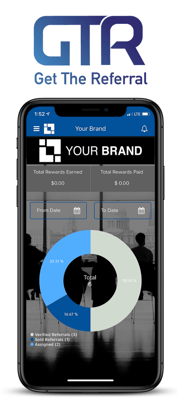 4.2. Make a plan to communicate and reach out to your referral sources.
4.2. Make a plan to communicate and reach out to your referral sources.
After your company receives a referral, you need to know exactly what to do with that and when. Create a plan with timelines to call, schedule an appointment, send a proposal, and follow up, so your referrals don’t get lost. It’s also important to send the referral status to the Advocates (and reward them correctly) to keep them accountable and excited about the whole referral process.
Take the Airbnb Refer-a-Friend Program. At first, it was a simple link that offered discounts to people who referred them to friends and family. When this brought them millions of dollars in revenue, they started a whole email campaign and other programs to understand their customers more and even educate them about other referral benefits.
4.3. Make sure referral sources have visibility into their referrals and payments.
An automated rewards system to quickly reward your Advocates is ideal to prompt them to make more referrals. You can tailor your rewards system to best fit your business. With a customer referral program in place, you can see daily results right on your dashboard and offer more than one option of payment such as gift cards, bank transfers, virtual debit cards, etc. You increase your chances of having more referrals when you pay rewards easily and fast. Think about how easy it is for Uber, Slack, and even Dropbox, who reward you with discounts instantly if a contact uses your referral link or invitation. PayPal, after growing immensely with a generous referral program for consumers through a simple link or invite, now limits their referral program to merchants and businesses, offering them discounts when using them for transactions.
4.4. Create resources, Examples, and ideas to educate your referral sources.
Educating your referral sources include many avenues: it is essential to get your employees on board with your referral program. You want them to be as comfortable as possible when promoting the referral program to their customers since they will be the fuel to the referral engine. You need a good project management system to train them, constantly bring the topic on sales meetings, and provide incentives for a great referral performance.
For your customers and prospects: your homepage is the hub of most traffic on your business website, that’s why you need to place the campaign for your referral program right there or a similarly prominent landing page, rather than in a side menu, which will attract the most amount of recognition. Stitch Fix, the personal stylist service, using a landing page to educate people about the referral link they can use in order to get credit.
Also, if possible, create videos to explain to people the benefits of becoming an advocate, how they can submit referrals, and what they would earn for that.
5. Successful Stories of Referral Programs.
The stories below show companies that implemented referral platforms and have seen significant improvements in their relationship with customers, besides the amazing results!
Safe Haven and GTR: Safe Haven is a home security company, who uses GetTheReferral as a strategic tool to work with Real Estate Agents/Brokers in order to more effectively connect with their clients and increase the number of referrals through these relationships. Back in April 2019, when we interviewed Ryan Ross, the Inside Sales Director, the company had already 4,127 deals sold after 5 months of the referral program implementation. Now this number is almost 11,000! Read more
D1 Training and GTR: Even before the official opening day, D1 Training was using the referral program with family and friends and expanded afterward for all members. The results came really quick, after less than a month of open doors, they already had 22 Advocates, and 92 Referrals (an amazing average of 4.18 referrals per advocate). Read more
Car Dealerships and GTR: our top car dealership customer (who couldn’t disclosure the company’s name for strategic reasons) is also having great results since the GTR platform implementation. After 5 months, they were able to generate more than 2,000 referrals, with 450 advocates (also, an amazing average of almost 5 referrals per advocate).



